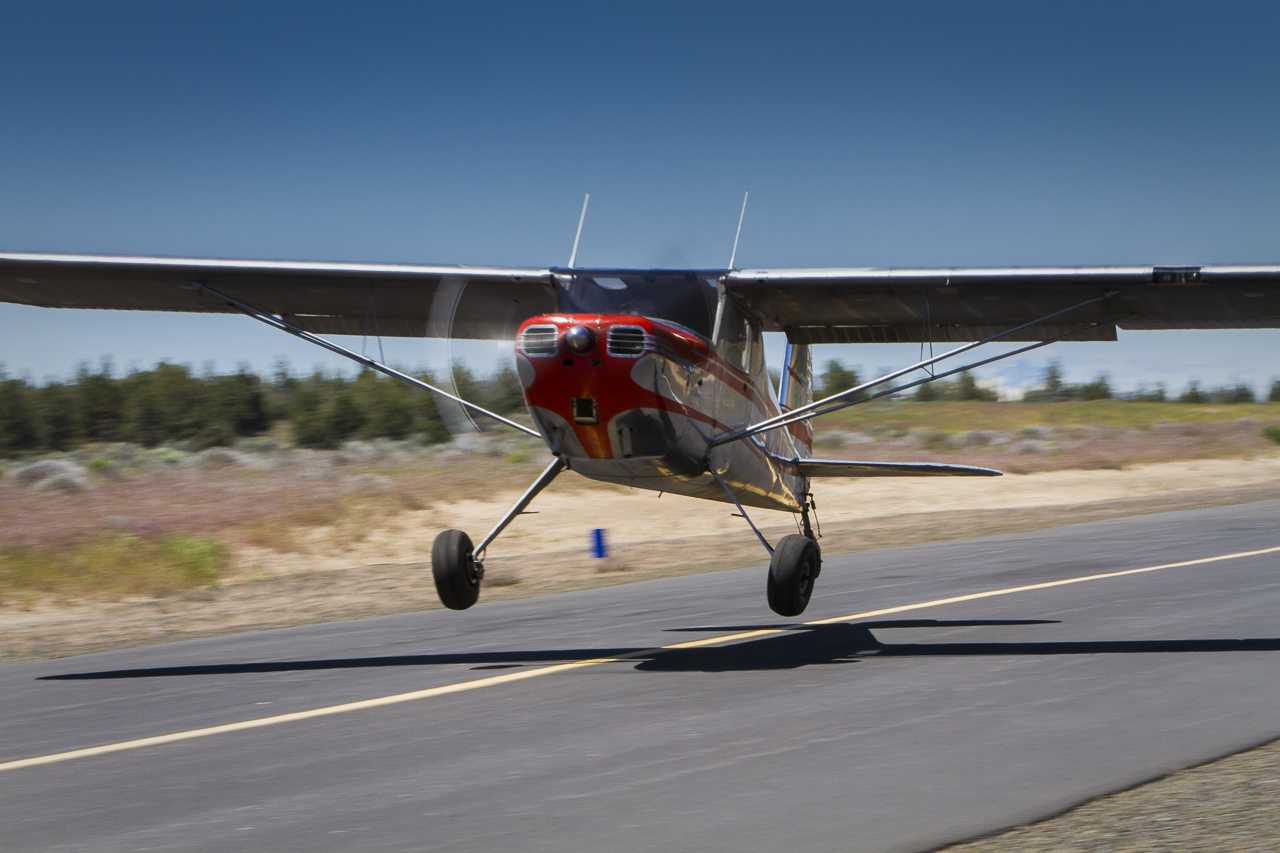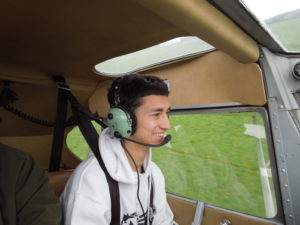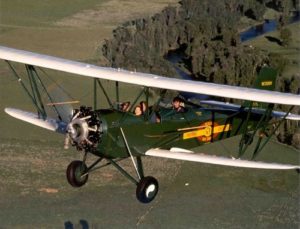I’m talking about landings. In our tailwheel airplanes we have two basic methods of landing, the Three Point landing and the Wheel Landing. The approach can be identical, but the two are different in the way the airplane contacts the ground. Refer to the title of this little piece. If you are in the business of teaching and writing about flying, you will hear words of advice and “how-to” ad nauseum about these two methods. They are virtually ALL too complicated. Let’s take the first one, the Three Point landing.
I hear so many words of advice to the person having trouble with it, from “find the landing attitude and hold it” to “the key is an appropriate approach speed”. I’m sorry, but in my very humble opinion, the authors of those pieces of advice have their heads securely lodged in their nether regions. Since you’ve stayed with me this far, I’ll assume you may be a little interested in MY advice. Here it is: Keep it in the “window”. Period.
 The Tailwheel Town 140 in “the window”
The Tailwheel Town 140 in “the window”
You see, it doesn’t make any difference how fast your approach speed is and I won’t even dignify the attitude advice. If you simply fly the airplane into the “window of acceptable altitude” (that’s between about 1 millimeter and a couple of feet) and keep it there as long as you possibly can with no power, two things will happen. You will run out of the ability to increase the lift necessary to maintain that little amount of altitude and your wheels, all three of them, will contact the ground. That’s it. Want to make it smoother? Then make the window of acceptable altitude lower. If you can keep the airplane three inches off the ground until it “pays off” or stalls or you simply run out of back stick, you’ll have a really cool landing.
Now some more little details: I hear a lot of fliers exclaim, “Oh, crap! I touched with the tailwheel first!” They are complaining about nothing. A proper three point landing is one in which the airplane contacts the ground with full aft stick. If its stalling angle of attack is higher than its “sitting on the ground” attitude, it’ll touch with its tailwheel first. No biggy, that’s the way it’s supposed to be. Don’t worry about it. The only way to truly execute a “three-point” landing in such an airplane is to touch down before it is stalled. I’d rather the plane be stalled than literally three-pointed, so the best three point landings I ever demonstrate in my 140 are tailwheel first landings. I call ‘em “ker-plop” landings.
Virtually every other concern you may have about the execution of your three point landing will be answered if you simply “hold it off”. Now, if you read what I said about the “window of acceptable altitude”, you’ll know why you’re having trouble with this landing. After all, only two things can really go wrong and they both have to do with that window that you can’t seem to stay in. Either you’ll over-flare and balloon up, leaving the window, or you’ll fail to use enough elevator and you’ll touch the ground, again LEAVING THE WINDOW. It’s like the guy who goes to the doctor and tells him, “Doc, it hurts when I go like this”. The Doctor then advises, “Then don’t go like that”. STAY IN THE WINDOW.
Now, on to the Wheelie: First I must address the prejudice held by many members of the “Geezer Patrol”. Sorry, guys, but you are all wet. Just like the guy who brags, “I never use my brakes”, you are doing yourself a huge disservice by eschewing the wheel landing. For one thing, you are a passenger at the moment of stall. I’d rather be the pilot. That’s why I do so many wheelies, even when I’m by myself.
Okay, now the “how-to”. Like many maneuvers, the Wheel landing has a mnemonic. It is “Swoop, Sink, Plant”. If you remember each of those three steps you’ll be fine. If you forget any of them, you’ll regret it. Let’s take them one at a time.
“Swoop”. That’s nothing more than resisting the urge to gradually raise the nose and thus decrease the airspeed long before you reach the point of intended landing. And before you exclaim, “Who, me?”, let me tell you that fully 90 percent of the people who come to me for tailwheel endorsements or master classes do it. Don’t. Now you have saved valuable airspeed, which you will need for the second stage.
“Sink”. When you’ve swooped to within five feet or so of the runway, you’ll stop the swoop and begin the “Sink”. You’ll also change where you’re looking. Before, you were looking at a target, the point where you were going to swoop to and stop at five feet of altitude. It was probably the numbers on a hard-surfaced runway. But once you stopped that swoop, look up at infinity and begin to use that airspeed and angle of attack not to regulate the attitude, but rather to regulate the sink rate. Find a magic, although changing, amount of elevator, which will give you a nice, stable and slow sink rate. As you are sinking, think about the last stage, otherwise you’re liable to be too busy patting yourself on the back for a soft touch to notice the bounce you just created by failing to PLANT.
“Plant”. The “Plant” is nothing more than applying the correct amount of elevator to maintain the same pitch attitude you had at the moment of contact. This is important because at the moment of contact, the mains can’t go any further down. But Mister Tailwheel still has a way to go and since he has some mass, he’s going to want to go down. But if you allow that tail to continue its descent, you will be allowing the angle of attack to increase. And since you have a slight surplus of airspeed, you’ll increase the lift and BINGO, a Bounce is born.
What can go wrong? Probably the most common error is failing to plant (remember the back patting? ) That’s followed by failure to control the sink, usually resulting in a bounce because it was so flippin’ fast!
Remember when I asked the question which became the title of this article? I think people make it complicated because they don’t work hard enough at the very simple fundamentals of this landing. They deal with the side effects of doing it wrong instead. If you simply follow the simple rules of “Keep it in the window” and “Swoop, sink and plant” your troubles will be over. See, I told you it was simple!
But, what if you screw it up, simple as it is. The result of that mistake, may be “The Dreaded Bounce”. And that is the title of our text article. Stay tuned!!!
And in the meantime, Happy Swooping!
Brian
 The Tailwheel Town 140 in “the window”
The Tailwheel Town 140 in “the window”


